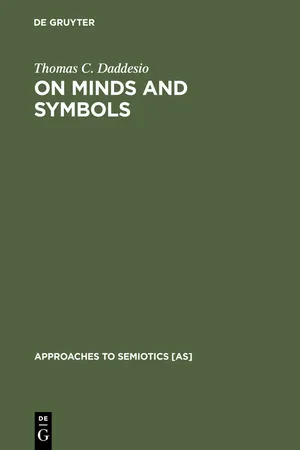
- 271 pages
- English
- PDF
- Available on iOS & Android
eBook - PDF
About this book
No detailed description available for "On Minds and Symbols".
Frequently asked questions
Yes, you can cancel anytime from the Subscription tab in your account settings on the Perlego website. Your subscription will stay active until the end of your current billing period. Learn how to cancel your subscription.
At the moment all of our mobile-responsive ePub books are available to download via the app. Most of our PDFs are also available to download and we're working on making the final remaining ones downloadable now. Learn more here.
Perlego offers two plans: Essential and Complete
- Essential is ideal for learners and professionals who enjoy exploring a wide range of subjects. Access the Essential Library with 800,000+ trusted titles and best-sellers across business, personal growth, and the humanities. Includes unlimited reading time and Standard Read Aloud voice.
- Complete: Perfect for advanced learners and researchers needing full, unrestricted access. Unlock 1.4M+ books across hundreds of subjects, including academic and specialized titles. The Complete Plan also includes advanced features like Premium Read Aloud and Research Assistant.
We are an online textbook subscription service, where you can get access to an entire online library for less than the price of a single book per month. With over 1 million books across 1000+ topics, we’ve got you covered! Learn more here.
Look out for the read-aloud symbol on your next book to see if you can listen to it. The read-aloud tool reads text aloud for you, highlighting the text as it is being read. You can pause it, speed it up and slow it down. Learn more here.
Yes! You can use the Perlego app on both iOS or Android devices to read anytime, anywhere — even offline. Perfect for commutes or when you’re on the go.
Please note we cannot support devices running on iOS 13 and Android 7 or earlier. Learn more about using the app.
Please note we cannot support devices running on iOS 13 and Android 7 or earlier. Learn more about using the app.
Yes, you can access On Minds and Symbols by Thomas C. Daddesio in PDF and/or ePUB format, as well as other popular books in Languages & Linguistics & Linguistics. We have over one million books available in our catalogue for you to explore.
Information
Table of contents
- Acknowledgements
- Introduction
- 1. Semiotics and cognition
- 1.1. Introduction
- 1.2. Critique of pure semiotics
- 1.3. Just how pure is pure semiotics?
- 1.4. Morris and Peirce on mentalism
- 1.5. Mentalism reconsidered
- 1.6. John Deely on signs and ideas
- 2. Cognition in the wake of the linguistic turn
- 2.1. Introduction
- 2.2. The linguistic turn
- 2.3. Antimentalism and formalism within the analytic tradition
- 2.4. Reasons for the cognitive shift
- 2.5. Problems with cognitivism: the language of thought and the formalist stance
- 2.6. The second phase of cognitivism
- 2.7. Connectionism and the multiplicity of mind
- 3. Beyond traditional mentalism
- 3.1. Introduction
- 3.2. General Principles of Cognitivism
- 3.3. Cognitivism and objections to traditional mentalism
- 3.4. The language of thought and computational theories of mind
- 4. Prelude to a cognitive theory of symbols
- 4.1. Introduction
- 4.2. Truth conditions, conventions, and cultural units
- 4.3. On symbols and indices
- 4.4. Symbols reconsidered
- 4.5. Conclusion
- 5. Steps towards a theory of representations
- 5.1. Introduction
- 5.2. Criteria for evaluating cognitive theories
- 5.3. Preliminaries for a theory of representations
- 5.5. Dretske's model of elementary behavior
- 6. Functional autonomy and the arbitrariness of symbols
- 6.1. Introduction
- 6.2. Perception and understanding
- 6.3. Functional autonomy
- 6.4. Functional autonomy and the relation of signification
- 6.5. Functional autonomy and cross-modal transfers
- 6.6. Functional autonomy and imagination
- 6.7. Functional autonomy and the evolution of symbolic communication
- 7. The development of symbolic communication in children
- 7.1. Introduction
- 7.2. Piaget’s sensorimotor period and the child's first words
- 7.3. Intentions in young children
- 7.4. The child's conceptual system
- 7.5. Pure performatives and functional autonomy
- 7.6. Cognition and social development
- 7.7. Conclusion
- Afterword
- Notes
- References
- Index of Names
- Subject Index